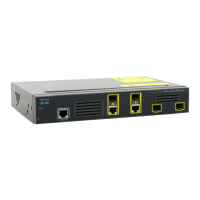Data Sheet
© 2008-2009 Cisco Systems, Inc. All rights reserved. This document is Cisco Public Information. Page 11 of 21
Network Security
Comprehensive security
solutions
Subscriber security
●
IEEE 802.1x allows dynamic, port-based security by providing user authentication.
●
IEEE 802.1x with VLAN assignment allows a dynamic VLAN assignment for a specific user
regardless of where the user is connected.
●
IEEE 802.1x and port security are provided to authenticate the port and manage network
access for all MAC addresses.
●
IEEE 802.1x readiness check simplifies deployment by generating a report for end hosts
capable of 802.1x.
●
802.1x supplicant helps mitigate security threats in the Carrier Ethernet access network by
having the switch (with a supplicant) securely authenticate itself with an upstream switch.
●
An absence of local switching behavior provides security and isolation between UNIs, helping
ensure that users cannot monitor or access other users’ traffic on the same switch.
●
DHCP Snooping prevents malicious users from spoofing a DHCP server and sending out
bogus addresses. This feature also prevents numerous other attacks such as Address
Resolution Protocol (ARP) poisoning.
●
Dynamic ARP Inspection helps ensure user integrity by preventing malicious users from
exploiting the insecure nature of the ARP protocol.
●
IP Source Guard prevents a malicious user from spoofing or taking over another user’s IP
address by creating a binding table between client’s IP and MAC address, port, and VLAN.
Switch security
●
Control Plane Security prevents DoS attacks on the CPU.
●
Configurable control plane security on ENI provides service providers the flexibility to
selectively discard or peer with customer’s control plane traffic on a per-port, per-protocol
basis.
●
Secure Shell (SSH) Protocol, Kerberos, and SNMPv3 provide network security by encrypting
administrator traffic during Telnet and SNMP sessions. SSH, Kerberos, and the cryptographic
version of SNMPv3 require a special cryptographic software image because of U.S. export
restrictions.
●
Port security secures the access to an access or trunk port based on MAC address. After a
specific timeframe, the aging feature removes the MAC address from the switch to allow
another device to connect to the same port.
●
Multilevel security on the console access prevents unauthorized users from altering the switch
configuration.
●
TACACS+ and RADIUS authentication facilitate centralized control of the switch and restrict
unauthorized users from altering the configuration.
●
Configuration File Security helps ensure that only authenticated users have access to the
configuration file.
●
MAC address learning and aging notifications allow administrators to keep track of subscriber
activities.
Network security
●
Cisco security VLAN ACLs on all VLANs prevent unauthorized data flows from being bridged
within VLANs.
●
Cisco standard and extended IP security router ACLs define security policies on routed
interfaces for control-plane and data-plane traffic.
●
Port-based ACLs for Layer 2 interfaces allow for application of security policies on individual
switch ports.
●
MAC address notification allows administrators to be notified of users added to or removed
from the network.
Network monitoring
●
Remote Switched Port Analyzer (RSPAN) allows for remote monitoring of the user interface.
●
Bidirectional data support on the Switched Port Analyzer (SPAN) port allows the Cisco
intrusion detection system to take action when an intruder is detected.

